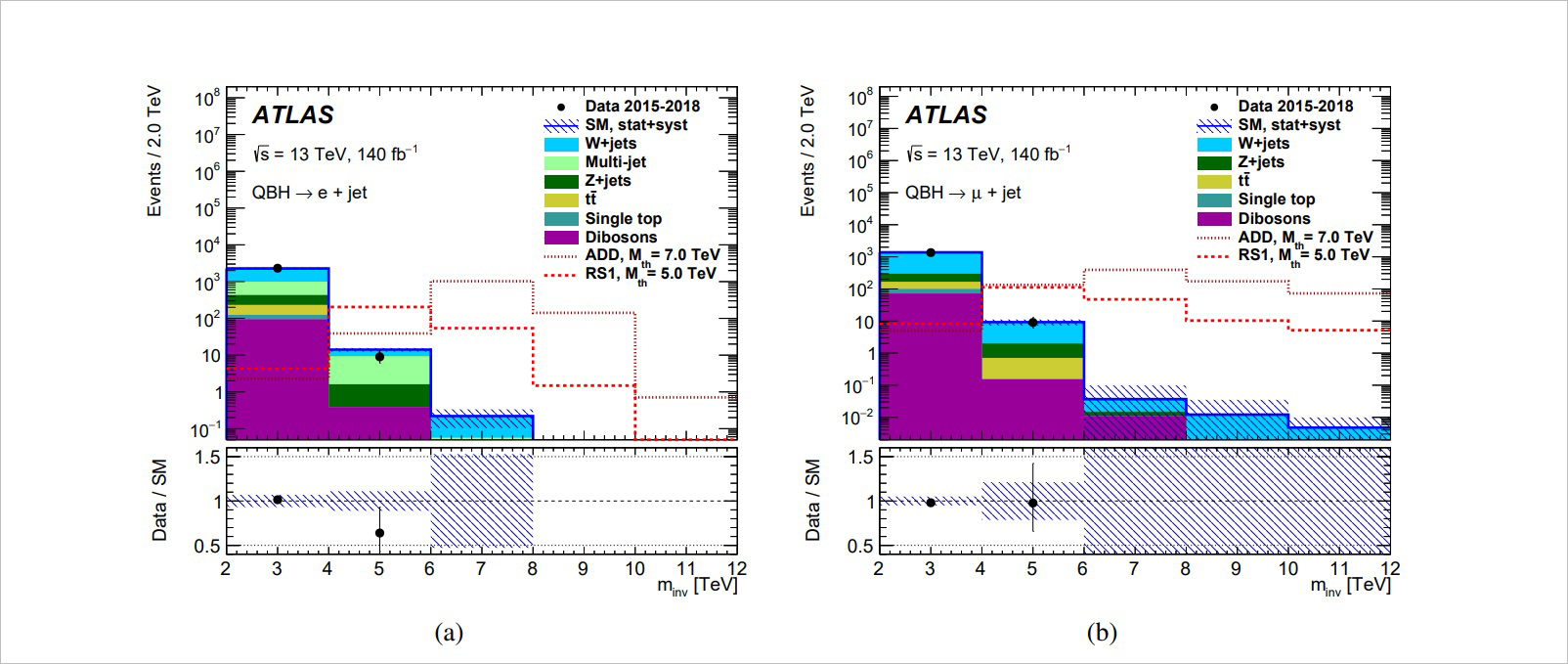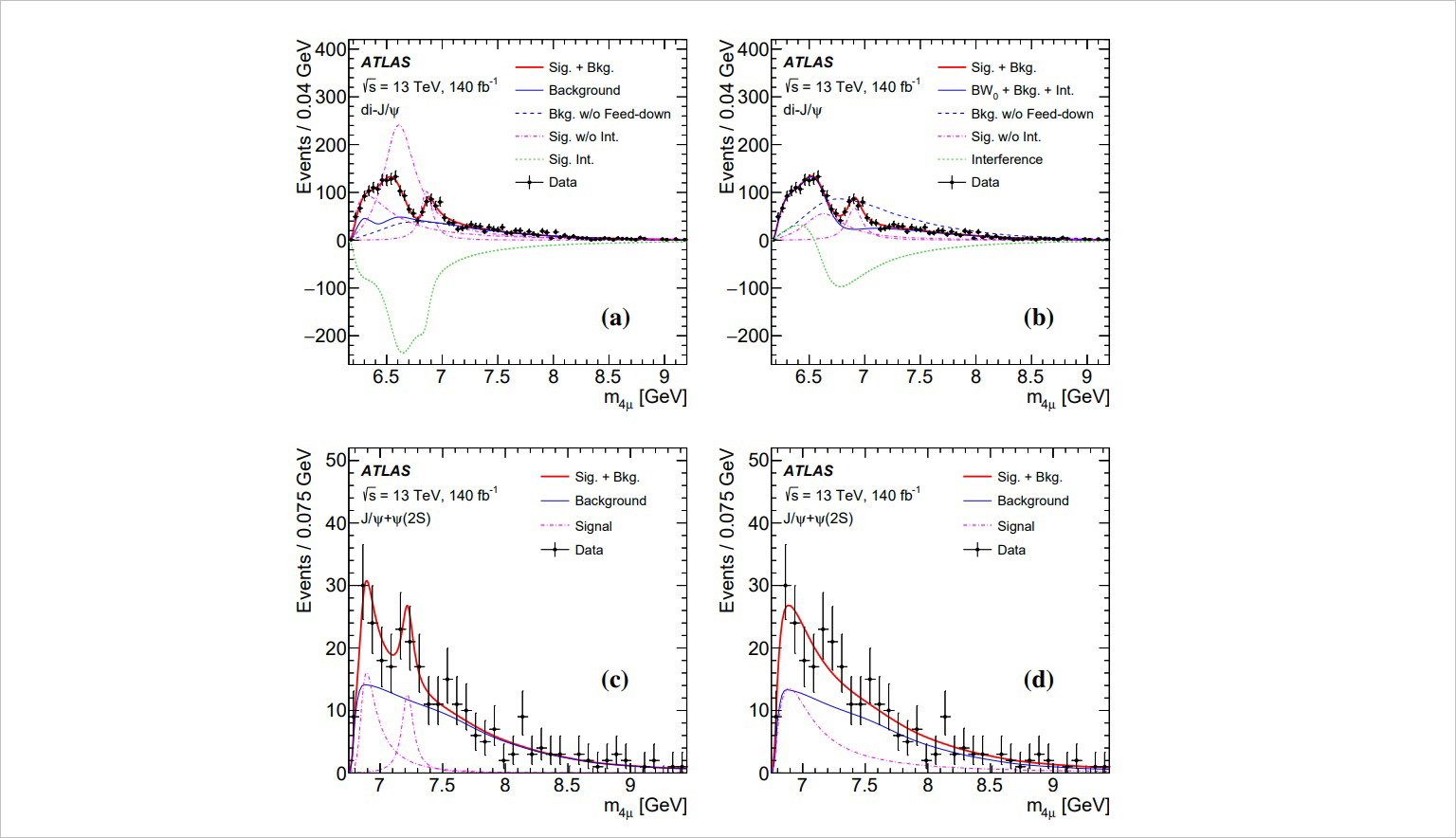ATLAS Collaboration with JINR participation obtained new results
News, 05 September 2023
In August of this year, the ATLAS Collaboration published articles on the measurements of the Higgs boson mass and the effective lifetime of the Bs0 meson in muon-antimuon decays. In July, a collaboration preprint dedicated to the search for quantum black hole production in hadron-electron decays was published. One more scientific paper published in April informs about the search for bound states in the production of a vector meson pair. All these scientific papers present the combined statistics of particle collision analysis obtained during Run 1 and Run 2 at the Large Hadron Collider at CERN. The first two studies were conducted with the participation of scientists from the Petersburg Nuclear Physics Institute of the National Research Centre “Kurchatov Institute”, the third and the fourth ones were carried out with the participation of employees from the Joint Institute for Nuclear Research. So far, none of the studies has received any indication of going beyond the Standard Model.
 A co-author of the studies, Head of the Sector of Elementary Particles of the Laboratory of Nuclear Problems at JINR Evgeny Khramov commented on the results obtained by ATLAS, to which physicists of the two scientific centres contributed.
A co-author of the studies, Head of the Sector of Elementary Particles of the Laboratory of Nuclear Problems at JINR Evgeny Khramov commented on the results obtained by ATLAS, to which physicists of the two scientific centres contributed.
In July of this year, the ATLAS Collaboration published a preprint dedicated to the search for quantum black hole production in hadron-electron decays. Quantum black holes have nothing in common with their astrophysical namesakes. Black holes familiar to us are produced as a result of a massive star collapse, a process when it rapidly compresses under the influence of its own mass, transforming into a region of spacetime that attracts all other objects, even moving at the speed of light. Quantum black holes are objects with additional dimensions, a hypothetical prediction beyond the Standard Model. Their existence is described in the theories of multidimensional space. It is considered that if space really has extra hidden dimensions, then microscopic black holes could have appeared in the early Universe immediately after the Big Bang. If it is so, then it could be possible to produce quantum holes at the most powerful of the currently operating accelerators. It is expected that such microscopic black holes will not absorb matter, but, on the contrary, instantly emit radiation and decay during 10-26 seconds right after that.
 Fig. 1. The distributions of events over the invariant mass of the leading lepton and the leading jet in the SR for data (points with error bars) and for SM backgrounds (solid histograms) after the background-only fit are shown in:(a) the electron+jet and (b) the muon+jet channels
Fig. 1. The distributions of events over the invariant mass of the leading lepton and the leading jet in the SR for data (points with error bars) and for SM backgrounds (solid histograms) after the background-only fit are shown in:(a) the electron+jet and (b) the muon+jet channels
“We have set very high limits on quantum black hole existence. In two main theoretical models, scientists excluded the production possibility of such holes at energies below 6.8 and 9.2 TeV,” Evgeny Khramov said.
Another study with the participation of JINR scientists focused on the search for new states in decays into vector meson pairs. More specifically, the detection and study of the so-called bound states, such as tetraquarks and pentaquarks discovered in 2014-15 at the LHC. Scientists obtain these bound states using muons, which, in turn, are a decay channel of the J/ψ meson pair (J/psi mesons) produced in proton-proton interactions. One more channel of four muon production interesting for scientists is a J/ψ-ϕ2s-meson pair.
“In bound states, we are looking for a new peak that we have not seen before. So far, all data are consistent with the Standard Model – researchers predict bound states of quarks in it,” – Evgeny Khramov explained. However, he noted that, there were no accurate predictions of the mass of those states. A collaboration of another experiment at the Large Hadron Collider, LHCb, has published results that revealed a bound state at a mass of 6.9 GeV/s2. At the same time, the observed tetraquark consisted of four identical quarks – two C and two anti-C. Now, this result should be checked by ATLAS.
 Fig. 2. The fit to the mass spectra in the signal regions in the di-𝐽/𝜓 (a,b) and 𝐽/𝜓+𝜓(2S) (c,d) channels. The purple dash-dotted lines represent the components of individual resonances, and the green short dashed ones represent the interferences among them
Fig. 2. The fit to the mass spectra in the signal regions in the di-𝐽/𝜓 (a,b) and 𝐽/𝜓+𝜓(2S) (c,d) channels. The purple dash-dotted lines represent the components of individual resonances, and the green short dashed ones represent the interferences among them
Employees from the Petersburg Nuclear Physics Institute of the National Research Centre «Kurchatov Institute» (PNPI) involved in the ATLAS Experiment were measuring the mass of the Higgs boson and the effective lifetime of the Bs0 meson. Colleagues from PNPI combined the results of two previous runs at the LHC, Run 1 (2009-2013) and Run 2 (2015-2019). At the same time, researchers studied very rare decays, so it took several years to collect statistics for them.
Thus, researchers measured the Higgs boson mass in two decay channels: the Н→γγ channel with two photons and the Н→ZZ(*) → 4l with four leptons (in those particular channels at ATLAS and CMS, scientists discovered the Higgs boson in 2012). The combined statistics indicated the Higgs boson mass as mHATLAS = 125.11 ± 0.11 GeV/c2. “The Higgs boson mass is involved in the predictions of other particles’ mass, because the interaction with the Higgs field generates their own masses. Before the Higgs boson discovery, there was no direct prediction for its mass. Its values varied up to TeVs,” Evgeny Khramov commented on the importance of the measurement.
The second result obtained with the participation of PNPI and published in August this year was the measurement of the effective Bs0 meson lifetime in the muon-antimuon decay Bs0 → μ+μ–. Unlike the Higgs boson mass, it was calculated in the Standard Model with the value of about one and a half picoseconds: τμμSM = (1.624 ± 0.009) ps. Significant deviations from this interval can help in the search for new physics. “Bs0 is a classic of searching for signals or signs of physics beyond the Standard Model. If researchers suddenly obtain another lifetime in Bs0 decay into a muon pair, it will suggest the existence of new physics,” Evgeny Khramov explained, indicating that there are certain difficulties in this direction of scientific search.
Specialists measured the effective lifetime of Bs0 in three experiments at the Large Hadron Collider. The LHCb and CMS collaborations obtained values of 2.07 ± 0.29 ps and 1.83−0.20+0.23 ps respectively, which were more than calculated value within SM. However, ATLAS showed a value smaller than in SM: τμμ= (0.99−0.07+0.42 (stat.) ±0.17 (syst.)) ps. “Results indicated measurements more or less equally distant from ones in the Standard Model, but some of them turned to be more and some of them less. Such deviations make it impossible to interpret the lifetime as a suggestion of new physics. Values that deviate significantly does not mean anything. Unfortunately, these measurements are not a direct search for new physics – they could suggest its existence but do not specify it in any way,” the scientists said.
Researchers keep carrying out all these measurements during Run 3 at LHC (2022-2026). “We would like to obtain measurements as precise as possible, because they are not final yet – the answers are still far away,” Evgeny Khramov concluded.
At present, the collaboration with JINR scientists is preparing a publication on the study of pentaquarks and tetraquarks at ATLAS. Scientists from JINR and PNPI NRC KI keep actively analysing data obtained during Run 2 and collecting data in Run 3.